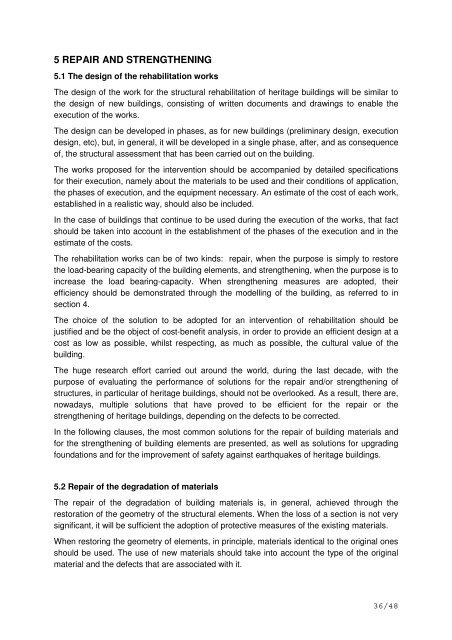Guide for the Structural Rehabilitation of Heritage ... - Test Input
Guide for the Structural Rehabilitation of Heritage ... - Test Input
Guide for the Structural Rehabilitation of Heritage ... - Test Input
You also want an ePaper? Increase the reach of your titles
YUMPU automatically turns print PDFs into web optimized ePapers that Google loves.
5 REPAIR AND STRENGTHENING5.1 The design <strong>of</strong> <strong>the</strong> rehabilitation worksThe design <strong>of</strong> <strong>the</strong> work <strong>for</strong> <strong>the</strong> structural rehabilitation <strong>of</strong> heritage buildings will be similar to<strong>the</strong> design <strong>of</strong> new buildings, consisting <strong>of</strong> written documents and drawings to enable <strong>the</strong>execution <strong>of</strong> <strong>the</strong> works.The design can be developed in phases, as <strong>for</strong> new buildings (preliminary design, executiondesign, etc), but, in general, it will be developed in a single phase, after, and as consequence<strong>of</strong>, <strong>the</strong> structural assessment that has been carried out on <strong>the</strong> building.The works proposed <strong>for</strong> <strong>the</strong> intervention should be accompanied by detailed specifications<strong>for</strong> <strong>the</strong>ir execution, namely about <strong>the</strong> materials to be used and <strong>the</strong>ir conditions <strong>of</strong> application,<strong>the</strong> phases <strong>of</strong> execution, and <strong>the</strong> equipment necessary. An estimate <strong>of</strong> <strong>the</strong> cost <strong>of</strong> each work,established in a realistic way, should also be included.In <strong>the</strong> case <strong>of</strong> buildings that continue to be used during <strong>the</strong> execution <strong>of</strong> <strong>the</strong> works, that factshould be taken into account in <strong>the</strong> establishment <strong>of</strong> <strong>the</strong> phases <strong>of</strong> <strong>the</strong> execution and in <strong>the</strong>estimate <strong>of</strong> <strong>the</strong> costs.The rehabilitation works can be <strong>of</strong> two kinds: repair, when <strong>the</strong> purpose is simply to restore<strong>the</strong> load-bearing capacity <strong>of</strong> <strong>the</strong> building elements, and streng<strong>the</strong>ning, when <strong>the</strong> purpose is toincrease <strong>the</strong> load bearing-capacity. When streng<strong>the</strong>ning measures are adopted, <strong>the</strong>irefficiency should be demonstrated through <strong>the</strong> modelling <strong>of</strong> <strong>the</strong> building, as referred to insection 4.The choice <strong>of</strong> <strong>the</strong> solution to be adopted <strong>for</strong> an intervention <strong>of</strong> rehabilitation should bejustified and be <strong>the</strong> object <strong>of</strong> cost-benefit analysis, in order to provide an efficient design at acost as low as possible, whilst respecting, as much as possible, <strong>the</strong> cultural value <strong>of</strong> <strong>the</strong>building.The huge research ef<strong>for</strong>t carried out around <strong>the</strong> world, during <strong>the</strong> last decade, with <strong>the</strong>purpose <strong>of</strong> evaluating <strong>the</strong> per<strong>for</strong>mance <strong>of</strong> solutions <strong>for</strong> <strong>the</strong> repair and/or streng<strong>the</strong>ning <strong>of</strong>structures, in particular <strong>of</strong> heritage buildings, should not be overlooked. As a result, <strong>the</strong>re are,nowadays, multiple solutions that have proved to be efficient <strong>for</strong> <strong>the</strong> repair or <strong>the</strong>streng<strong>the</strong>ning <strong>of</strong> heritage buildings, depending on <strong>the</strong> defects to be corrected.In <strong>the</strong> following clauses, <strong>the</strong> most common solutions <strong>for</strong> <strong>the</strong> repair <strong>of</strong> building materials and<strong>for</strong> <strong>the</strong> streng<strong>the</strong>ning <strong>of</strong> building elements are presented, as well as solutions <strong>for</strong> upgradingfoundations and <strong>for</strong> <strong>the</strong> improvement <strong>of</strong> safety against earthquakes <strong>of</strong> heritage buildings.5.2 Repair <strong>of</strong> <strong>the</strong> degradation <strong>of</strong> materialsThe repair <strong>of</strong> <strong>the</strong> degradation <strong>of</strong> building materials is, in general, achieved through <strong>the</strong>restoration <strong>of</strong> <strong>the</strong> geometry <strong>of</strong> <strong>the</strong> structural elements. When <strong>the</strong> loss <strong>of</strong> a section is not verysignificant, it will be sufficient <strong>the</strong> adoption <strong>of</strong> protective measures <strong>of</strong> <strong>the</strong> existing materials.When restoring <strong>the</strong> geometry <strong>of</strong> elements, in principle, materials identical to <strong>the</strong> original onesshould be used. The use <strong>of</strong> new materials should take into account <strong>the</strong> type <strong>of</strong> <strong>the</strong> originalmaterial and <strong>the</strong> defects that are associated with it.36/48
















